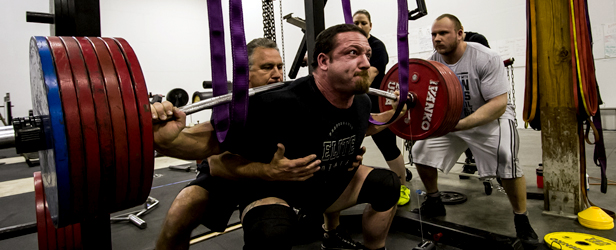
I recently had the pleasure of working with IFBB Pro Amit Sapir as he preps for an all-time world record squat at GPA worlds in a few weeks. Amit had some obstacles to overcome based on his body structure and his past experience as an Olympic lifter. His squat pattern combined with his body structure simply would not allow him to physically hit depth, even with his hamstrings sitting on his calves. I took him all the way down to a 10-inch box but, due to the extreme leg dive and his massive leg size and small knees, he was still squatting high.
With only a few days to work together and the meet in only a few weeks, there was no chance of completely rebuilding his squat into a powerlifting squat. We simply couldn’t address every issue.
This is the approach I used to improve his squats in just three training sessions over the course of three days.
Day 1
Step 1: Assess
I watched his current squat pattern from multiple angles, looking at the movement and watching to asses several specific aspects of his movement:
- What was tight and engaged, what was passive, and what was firing movement
- Breathing and core stabilization (also tested physically)
- Natural stance and breathing patterns (what position is he in when standing and breathing normally?)
- Restrictions due to mobility
- Stance, foot placement, bar placement, and basic movement pattern
Step 2: Test
With the meet right around the corner I could only make changes that he could retain quickly without spending significant time to ingrain. We tested a number of different things to see what was manageable and to push him to experiment with entirely new patterns and see how he responded. We practiced a full powerlifting, posterior-dominant squat (as you will see in the day two video) with sitting back and full opening of hips allowing him to sit between his legs. Several different bar positions on the back were tested as well. Without physically reinforced cues, Amit was unable to retain the full transition to the posterior-dominant squat, which would have the optimal knee position for judging depth. The bar position and his lengthy walkout are both large areas for improvement, but testing showed that these are not significant issues standing in the way of his current goals.
Step 3: Develop Plan
The priority was to improve hip to knee perspective immediately. Based on testing and assessment the following simple plan and coaching cues were implemented:
- Stabilize core to provide strength needed in core to support pattern change of not bouncing off legs. This will build foundation for future on all lifts.
- Coached on diaphragmatic breathing, assigned daily homework, provided clinical video on myrehabexcercise.com
- Eliminate excessive arch and bring spine back to neutral to allow for opposition of diaphragm to pelvic floor for Intra-Abdominal Pressurization (IAP).
- Taught the Lewitt (will detail in future article/video) to teach rib cage position and IAP.
- Assigned a verbal and put into setup progression as step two.
- Coached on oblique pressurization and used physical hitting to teach him where and how to be hard.
- Assigned a verbal cue for Amit and put into setup progression as step 3.
- Open up the hips to eliminate knee dive and provide foundation for future of bigger squats as hip firing patterns improve.
- Lots of practice pushing/pulling Amit’s hips back and pushing his knees open to demonstrate and gain comfort with pattern.
- Brought his toe position in from his overly pronated setup to match his standing foot stance to allow for more glute engagement and balance.
- Increase (initiate) glute activity as the beginning of learning posterior-based squat and hip firing pattern.
- Taught “rooting” the feet to the floor and cued glutes with rooting and twisting the floor apart.
- Assigned verbal cue and put into setup progression step five.
- Upper back support to improve stabilization up to the bar and set foundation for additional improvements in biomechanics (based on his build and how I see his squat progressing) through a lower bar position in the future.
- Moved grip out a bit to eliminate shoulder mobility restrictions.
- Taught band RNT squat to improve scapular retraction and ability to setup on bar as shown here.
- Taught cueing of lats for stabilization, assigned verbal cue, and put into setup progression as step four.
Day 2
This was a short session with no weights. We worked on ingraining the patterns from the day prior and giving some homework he could take home to work on furthering his pattern. In the video, you can see Amit using a simple band around his knees to cue glute activation while he twists the floor. He also has a box in front of him to give him a physical cue to force him to sit back. It’s important for him to be working on all the IAP strategies in these patterns as well, and controlling his body all the way to the box. In the beginning you can see him plopping to the box the last inch but he gains control in the last rep or two shown demonstrating a near perfect squat!
We also worked through the band RNT squats again as well as a glute-activation sequence I have detailed on my YouTube instructional video playlist.
Day 3
Put it all to the test with weights:
- Glute activation sequence
- Band RNT squats
- Reviewed coaching points form past two days
- Squat using the five-step setup and verbal cue process we developed specific to his immediate needs
- Work up to world record level 705 @ 198 raw without wraps squat. He hit this to competition depth with ease.









